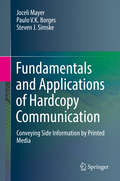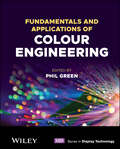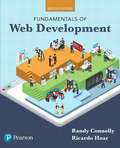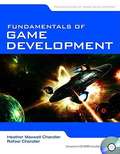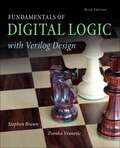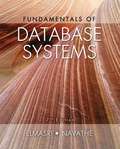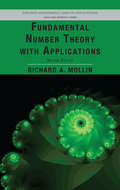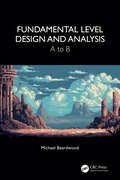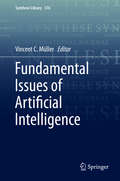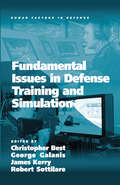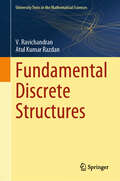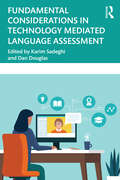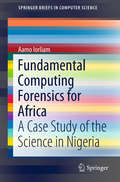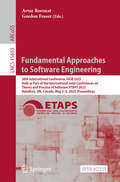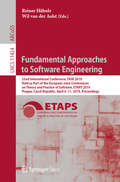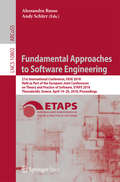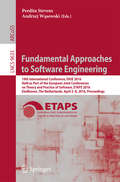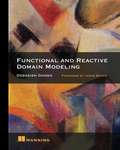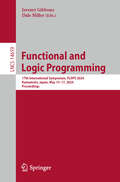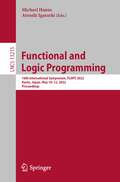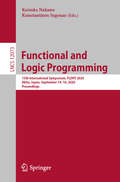- Table View
- List View
Fundamentals and Applications of Hardcopy Communication: Conveying Side Information By Printed Media
by Steven J. Simske Joceli Mayer Paulo V.K. BorgesThis book presents covert, semi-covert and overt techniques for communication over printed media by modifying images, texts or barcodes within the document. Basic and advanced techniques are discussed aimed to modulate information into images, texts and barcodes.Conveying information over printed media can be useful for content authentication, author copyright, information and piracy product deterrent, side information for marketing, among other applications. Practical issues are discussed and experiments are provided to evaluate competitive approaches for hard-copy communication.This book is a useful resource for researchers, practitioners and graduate students in the field of hard-copy communication by providing the fundamentals, basic and advanced techniques as examples of approaches to address the hard-copy media distortions and particularities.
Fundamentals and Applications of Colour Engineering (Wiley Series in Display Technology)
by Phil GreenFUNDAMENTALS AND APPLICATIONS OF COLOUR ENGINEERING EXPERT OVERVIEW OF THE WORLD OF COLOUR ENGINEERING IN THE 21ST CENTURY, WITH NEW, UPDATED TECHNOLOGIES AND A MATLAB TOOLBOX Fundamentals and Applications of Colour Engineering provides important coverage on topics that hold the power to extend our knowledge of colour reproduction, such as colour measurement and appearance and the methods used, with additional discussion of the technologies responsible for reproducing colour across a wide range of devices, together with the colour management systems that are used to connect devices and exchange information. Composed of 20 chapters, the Editor and his team of expert contributors consider the new ICC.2 architecture, an approach that introduces an evolutionary step in colour engineering, ensuring wider possibilities for technology. The text also considers the emerging applications for advanced colour management, such as processing spectral data, handling HDR images, and the capture and reproduction of material appearance. The text is supported by a MATLAB toolbox of relevant functions and data. Fundamentals and Applications of Colour Engineering is a useful reference for anyone involved in the reproduction of colour and a strong supplementary course potential for master???s degrees with a colour science component. Fundamentals and Applications of Colour Engineering includes information on: Instruments and methods of colour measurement, colorimetry, and colour difference, and colour appearance Colour spaces and colour encodings, and characterizing input devices, displays and printers Colour gamut communication and imaging standards, high dynamic range imaging, and HDR Sensor adjustment in colour management, open source tools for colour engineering, and colour transform evaluation Supporting active learning with the inclusion of a toolbox of relevant functions and data, Fundamentals and Applications of Colour Engineering is an essential resource for students in relevant programs of study, and for professionals within colour engineering and reproduction looking to maximize their skill set and keep their skills updated.
Fundamentals Of Web Development
by Randy Connolly Ricardo HoarWelcome to the Fundamentals of Web Development. This textbook is intended to cover the broad range of topics required for modern web development and is suitable for intermediate to upper-level computing students. A significant percentage of the material in this book has also been used by the authors to teach web development principles to first-year computing students and to non-computing students as well.
Fundamentals Of Game Development (Foundations of Game Development)
by Heather Maxwell Chandler Rafael ChandlerWritten by veterans who are currently working in the game industry, Fundamentals of Game Development is unique because it provides the practical aspects of the processes involved in developing and completing game projects. Designed for introductory game development and game production courses, this text provides a hands-on approach using examples and exercises to walk the reader through the entire process of developing a game from concept to completion. The book covers the basic topics discussed in an introductory text as well as history, game genres, design, story-telling, character creation, pre-production, code release, career descriptions, and more.
Fundamentals Of Digital Logic With Verilog Design
by Stephen Brown Zvonko VranesicFundamentals of Digital Logic With Verilog Designteaches the basic design techniques for logic circuits. It emphasizes the synthesis of circuits and explains how circuits are implemented in real chips. Fundamental concepts are illustrated by using small examples. Use of CAD software is well integrated into the book. The CAD software provides automatic mapping of a design written in Verilog into Field Programmable Gate Arrays (FPGAs) and Complex Programmable Logic Devices (CPLDs). Students will be able to try, firsthand, the book's Verilog examples (over 140) and homework problems. Engineers use Quartus CAD for designing, simulating, testing and implementing logic circuits. The version included with this text supports all major features of the commercial product and comes with a compiler for the IEEE standard Verilog language. Students will be able to: enter a design into the CAD system compile the design into a selected device simulate the functionality and timing of the resulting circuit implement the designs in actual devices (using the school's laboratory facilities) Verilog is a complex language, so it is introduced gradually in the book. Each Verilog feature is presented as it becomes pertinent for the circuits being discussed. To teach the student to use the Quartus CAD, the book includes three tutorials.
Fundamentals Of Database Systems
by Ramez Elmasri Shamkant B. NavatheFor database systems courses in Computer Science This book introduces the fundamental concepts necessary for designing, using, and implementing database systems and database applications. Our presentation stresses the fundamentals of database modeling and design, the languages and models provided by the database management systems, and database system implementation techniques. The book is meant to be used as a textbook for a one- or two-semester course in database systems at the junior, senior, or graduate level, and as a reference book. The goal is to provide an in-depth and up-to-date presentation of the most important aspects of database systems and applications, and related technologies. It is assumed that readers are familiar with elementary programming and data-structuring concepts and that they have had some exposure to the basics of computer organization.
Fundamental and Applied Scientific Research in the Development of Agriculture in the Far East: Agricultural Cyber-Physical Systems, Volume 1 (Lecture Notes in Networks and Systems #733)
by Aleksei Muratov Svetlana Ignateva Khasanov Sayidjakhon Zokirjon ugliThe scope of this book is cyber-physical systems used for the sustainable development and productivity of the agricultural sector. The book contains proceedings of the conference “Fundamental and Applied Scientific Research in the Development of Agriculture in the Far East” (AFE-2022, Tashkent, Uzbekistan). The results of research in the following areas are presented here: software-as-a-service solutions for orchard management, ICT components of Smart Agriculture (SA), farm management platforms, yield monitoring and estimation, IoTs in farming, water management, and smart agriculture machines. The book contains information on the latest technologies in precision agriculture, including real-time technology and big data analytics, fertilizer and sprayer controllers, robotics, variable rate irrigation, networks and remote sensing technologies, etc. The research results presented in the book help in making the right decisions about the allocation of resources in agricultural systems.
Fundamental Number Theory with Applications
by Richard A. MollinAn update of the most accessible introductory number theory text available, Fundamental Number Theory with Applications, Second Edition presents a mathematically rigorous yet easy-to-follow treatment of the fundamentals and applications of the subject. The substantial amount of reorganizing makes this edition clearer and more elementary in i
Fundamental Level Design and Analysis: A to B
by Michael BeardwoodThis book provides a starting point for anyone interested in level and game design with zero prior knowledge. By analysing existing games and levels, it introduces good design ideas and works towards communicating them in either design or practical methods. The book covers a multitude of design standards and showcases relatively easy methods of communicating ideas to an industry standard.This book uses step-by-step discussion to show how and why certain methodologies work, and covers the key topics needed to understand level design, including mapping, blockouts, flow maps, critical paths, and affordance.This book will be suitable for undergraduate students studying game design courses, as well as those looking to learn the basics of level design.
Fundamental Issues of Artificial Intelligence (Synthese Library #376)
by Vincent C. MüllerThis volume offers a look at the fundamental issues of present and future AI, especially from cognitive science, computer science, neuroscience and philosophy. This work examines the conditions for artificial intelligence, how these relate to the conditions for intelligence in humans and other natural agents, as well as ethical and societal problems that artificial intelligence raises or will raise. The key issues this volume investigates include the relation of AI and cognitive science, ethics of AI and robotics, brain emulation and simulation, hybrid systems and cyborgs, intelligence and intelligence testing, interactive systems, multi-agent systems, and super intelligence. Based on the 2nd conference on “Theory and Philosophy of Artificial Intelligence” held in Oxford, the volume includes prominent researchers within the field from around the world.
Fundamental Issues of Artificial Intelligence
by Vincent C. MüllerThis volume offers a look at the fundamentalissues of present and future AI, especially from cognitive science, computerscience, neuroscience and philosophy. This work examines the conditionsfor artificial intelligence, how these relate to the conditions for intelligencein humans and other natural agents, as well as ethical and societal problemsthat artificial intelligence raises or will raise. The key issues this volume investigates include the relation of AI andcognitive science, ethics of AI and robotics, brain emulation andsimulation, hybrid systems and cyborgs, intelligence and intelligence testing,interactive systems, multi-agent systems, and super intelligence. Based on the 2nd conference on "Theory and Philosophy of ArtificialIntelligence" held in Oxford, the volume includes prominentresearchers within the field from around the world.
Fundamental Issues in Defense Training and Simulation (Human Factors in Defence)
by George Galanis Robert SottilareDefense forces have always invested a great deal of their resources in training. In recent times, changes in the complexity and intensity of operations have reaffirmed the importance of ensuring that warfighters are adequately prepared for the environments in which they are required to work. The emergence of new operational drivers such as asymmetric threats, urban operations, joint and coalition operations and the widespread use of military communications and information technology networks has highlighted the importance of providing warfighters with the competencies required to act in a coordinated, adaptable fashion, and to make effective decisions in environments characterized by large amounts of sometimes ambiguous information. While investment in new technologies can make available new opportunities for action, it is only through effective training that personnel can be made ready to apply their tools in the most decisive and discriminating fashion. There are many factors which can have an impact on the efficacy of training and many issues to consider when designing and implementing training strategies. These issues are often complex and nuanced, and in order to grasp them fully a significant investment of time and energy is required. However, the requirement to respond quickly to ever-changing technology, a high operational tempo and minimal staffing may preclude many in today's defense forces from seeking out all such resources on their own. This edited collection provides brief, easy-to-understand summaries of the key issues in defense training and simulation, as well as guidance for further reading. It consists of a collection of short essays, each of which addresses a fundamental issue in defense training and simulation, and features an up-to-date reference list to enable the reader to undertake further investigation of the issues addressed. In essence, this book provides the optimum starting point, or first resource, for readers to come to terms with the important issues associated with defense training and simulation. The contributions are written by leading scholars from military research institutions in the US, UK, Canada, Australia and New Zealand, as well as selected researchers from academic and private sector research institutions.
Fundamental Discrete Structures (University Texts in the Mathematical Sciences)
by Atul Kumar Razdan V. RavichandranThis book serves as a core text in discrete mathematics. It discusses topics such as symbolic logic, enumerative combinatorics, algebraic structures, graph theory, and related applications to computer science and other allied subjects. The presentation of related concepts is suitable for sophomore, junior, and senior-level undergraduate students. Exercises provided at the end of each chapter are designed to help the reader have an active learning experience throughout the study.
Fundamental Considerations in Technology Mediated Language Assessment
by Karim Sadeghi and Dan DouglasFundamental Considerations in Technology Mediated Language Assessment aims to address issues such as how the forced integration of technology into second language assessment has shaped our understanding of key traditional concepts like validity, reliability, washback, authenticity, ethics, fairness, test security, and more. Although computer assisted language testing has been around for more than two decades in the context of high-stakes proficiency testing, much of language testing worldwide has shifted to 'at home' mode, and relies heavily on the mediation of digital technology, making its widespread application in classroom settings in response to the COVID-19 outbreak as unprecedented. Integration of technology into language assessment has brought with it countless affordances and at the same time challenges, both theoretically and practically. One major theoretical consideration requiring attention is the way technology has contributed to a re-conceptualisation of major assessment concepts/constructs. There is very limited literature available on theoretical underpinnings of technology mediated language assessment. This book aims to fill this gap. This book will appeal to academic specialists, practitioners or professionals in the field of language assessment, advanced and/or graduate students, and a range of scholars or professionals in disciplines like educational technology, applied linguistics and TESOL.
Fundamental Computing Forensics for Africa: A Case Study of the Science in Nigeria (SpringerBriefs in Computer Science)
by Aamo IorliamThis book presents a general introduction to the computational aspects of forensic science, covering the different tools needed for forensic investigations, the importance of forensics and biometrics, and the use of Benford’s law for biometrics and network traffic analysis. It specifically focuses on the application of these techniques in Africa, and how they can be of benefit in the investigation of crime in Nigeria in particular.
Fundamental Approaches to Software Engineering: 28th International Conference, FASE 2025, Held as Part of the International Joint Conferences on Theory and Practice of Software, ETAPS 2025, Hamilton, ON, Canada, May 3–8, 2025, Proceedings (Lecture Notes in Computer Science #15693)
by Gordon Fraser Artur BoronatThis open access book constitutes the proceedings of the 28th International Conference on Fundamental Approaches to Software Engineering, FASE 2025, which was held as part of the International Joint Conferences on Theory and Practice of Software, ETAPS 2025, in Hamilton, Canada, in May 2025. The 9 full and 2 short papers included in the proceedings, together with one invited keynote paper and 3 tool competition papers, were carefully reviewed and selected from 31 submissions. They deal with up to date research in software engineering and its applications in, e.g., quality and testing foundations for AI-based systems, requirements engineering, etc.
Fundamental Approaches to Software Engineering: 27th International Conference, FASE 2024, Held as Part of the European Joint Conferences on Theory and Practice of Software, ETAPS 2024, Luxembourg City, Luxembourg, April 6–11, 2024, Proceedings (Lecture Notes in Computer Science #14573)
by Ana Cavalcanti Dirk BeyerThis open access book constitutes the proceedings of the 27th International Conference on Fundamental Approaches to Software Engineering, FASE 2024, held in conjunction with ETAPS 2024 which took place in Luxembourg in April 2024. The 14 full papers included in this book were carefully reviewed and selected from 41 submission. The proceedings also include 5 short papers from the Test-Comp 2024 event that was hosted by FASE. They deal with the broad field of software engineering, focusing on requirements, design, architecture, modeling, applications of AI to software engineering and software engineering for AI-based systems, quality, model-driven engineering, processes, and software evolution.
Fundamental Approaches to Software Engineering: 26th International Conference, FASE 2023, Held as Part of the European Joint Conferences on Theory and Practice of Software, ETAPS 2023, Paris, France, April 22–27, 2023, Proceedings (Lecture Notes in Computer Science #13991)
by Leen Lambers Sebastián UchitelThis open access book constitutes the proceedings of the 26th International Conference on Fundamental Approaches to Software Engineering, FASE 2023, which was held during April 22-27, 2023, in Paris, France, as part of the European Joint Conferences on Theory and Practice of Software, ETAPS 2023. The 12 regular papers presented in this volume were carefully reviewed and selected from 50 submissions. The proceedings also contain 2 tool papers, 2 NIER papers, and 2 competition papers from the Test-Comp Competition. The papers deal with the foundations on which software engineering is built, including topics like software engineering as an engineering discipline, requirements engineering, software architectures, software quality, model-driven development, software processes, software evolution, AI-based software engineering, and the specification, design, and implementation of particular classes of systems, such as (self-)adaptive, collaborative, AI, embedded, distributed, mobile, pervasive, cyber-physical, or service-oriented applications. .
Fundamental Approaches to Software Engineering: 22nd International Conference, FASE 2019, Held as Part of the European Joint Conferences on Theory and Practice of Software, ETAPS 2019, Prague, Czech Republic, April 6–11, 2019, Proceedings (Lecture Notes in Computer Science #11424)
by Reiner Hähnle Wil van der AalstThis book is Open Access under a CC BY licence.This book constitutes the proceedings of the 22nd International Conference on Fundamental Approaches to Software Engineering, FASE 2019, which took place in Prague, Czech Republic in April 2019, held as Part of the European Joint Conferences on Theory and Practice of Software, ETAPS 2019.The 24 papers presented in this volume were carefully reviewed and selected from 94 submissions. The papers are organized in topical sections named: software verification; model-driven development and model transformation; software evolution and requirements engineering; specification, design, and implementation of particular classes of systems; and software testing.
Fundamental Approaches to Software Engineering: 21st International Conference, Fase 2018, Held As Part Of The European Joint Conferences On Theory And Practice Of Software, Etaps 2018, Thessaloniki, Greece, April 14-20, 2018, Proceedings (Lecture Notes in Computer Science #10802)
by Alessandra Russo Andy SchürrThis book is Open Access under a CC BY licence.This book constitutes the proceedings of the 21st International Conference on Fundamental Approaches to Software Engineering, FASE 2018, which took place in Thessaloniki, Greece in April 2018, held as Part of the European Joint Conferences on Theory and Practice of Software, ETAPS 2018.The 19 papers presented in this volume were carefully reviewed and selected from 63 submissions. The papers are organized in topical sections named: model-based software development; distributed program and system analysis; software design and verification; specification and program testing; family-based software development.
Fundamental Approaches to Software Engineering
by Andrzej Wąsowski Perdita StevensThis bookconstitutes the proceedings of the 19th International Conference on FundamentalApproaches to Software Engineering, FASE 2016, which took place in Eindhoven,The Netherlands, in April 2016, held as Part of the European Joint Conferenceson Theory and Practice of Software, ETAPS 2016. The 23 full papers presented in this volume were carefully reviewed and selectedfrom 90 submissions. They were organized in topical sections named: concurrentand distributed systems; model-driven development; analysis and bug triaging;probabilistic and stochastic systems; proof and theorem proving; andverification.
Functional and Reactive Domain Modeling
by Debasish GhoshSummaryFunctional and Reactive Domain Modeling teaches you how to think of the domain model in terms of pure functions and how to compose them to build larger abstractions.Purchase of the print book includes a free eBook in PDF, Kindle, and ePub formats from Manning Publications.About the TechnologyTraditional distributed applications won't cut it in the reactive world of microservices, fast data, and sensor networks. To capture their dynamic relationships and dependencies, these systems require a different approach to domain modeling. A domain model composed of pure functions is a more natural way of representing a process in a reactive system, and it maps directly onto technologies and patterns like Akka, CQRS, and event sourcing.About the BookFunctional and Reactive Domain Modeling teaches you consistent, repeatable techniques for building domain models in reactive systems. This book reviews the relevant concepts of FP and reactive architectures and then methodically introduces this new approach to domain modeling. As you read, you'll learn where and how to apply it, even if your systems aren't purely reactive or functional. An expert blend of theory and practice, this book presents strong examples you'll return to again and again as you apply these principles to your own projects.What's InsideReal-world libraries and frameworksEstablish meaningful reliability guaranteesIsolate domain logic from side effectsIntroduction to reactive design patternsAbout the ReaderReaders should be comfortable with functional programming and traditional domain modeling. Examples use the Scala language.About the AuthorSoftware architect Debasish Ghosh was an early adopter of reactive design using Scala and Akka. He's the author of DSLs in Action, published by Manning in 2010.Table of ContentsFunctional domain modeling: an introductionScala for functional domain modelsDesigning functional domain modelsFunctional patterns for domain modelsModularization of domain modelsBeing reactiveModeling with reactive streamsReactive persistence and event sourcingTesting your domain modelSummary - core thoughts and principles
Functional and Logic Programming: 17th International Symposium, FLOPS 2024, Kumamoto, Japan, May 15–17, 2024, Proceedings (Lecture Notes in Computer Science #14659)
by Dale Miller Jeremy GibbonsThis book constitutes the proceedings of the 17th International Symposium on Functional and Logic Programming, FLOPS 2024, held in Kumamoto, Japan, in May 2024. The 15 papers presented in this volume were carefully reviewed and selected from 28 submissions. The scope includes all aspects of the design, semantics, theory, applications, implementations, and teaching of declarative programming. FLOPS speci cally aims to promote cross-fertilization between theory and practice and among di erent styles of declarative programming.
Functional and Logic Programming: 16th International Symposium, FLOPS 2022, Kyoto, Japan, May 10–12, 2022, Proceedings (Lecture Notes in Computer Science #13215)
by Michael Hanus Atsushi IgarashiThis book constitutes the proceedings of the 16th International Symposium on Functional and Logic Programming, FLOPS 2022, held in Kyoto, Japan, in May 2022.The 12 papers presented in this volume were carefully reviewed and selected from 30 submissions. Additionally, the volume includes two system descriptions and a declarative pearl paper. The papers cover all aspects of the design, semantics, theory, applications, implementations, and teaching of declarative programming focusing on topics such as functional programming, logic programming, declarative programming, constraint programming, formal method, model checking, program transformation, program refinement, and type theory.
Functional and Logic Programming: 15th International Symposium, FLOPS 2020, Akita, Japan, September 14–16, 2020, Proceedings (Lecture Notes in Computer Science #12073)
by Keisuke Nakano Konstantinos SagonasThis book constitutes the proceedings of the 15th International Symposium on Functional and Logic Programming, FLOPS 2020, held in Akita, Japan*, in September 2020. The 12 papers presented in this volume were carefully reviewed and selected from 25 submissions. They cover all aspects of the design, semantics, theory, applications, implementations, and teaching of declarative programming focusing on topics such as functional programming, logic programming, declarative programming, constraint programming, formal method, model checking, program transformation, program refinement, and type theory. *The conference was held virtually due to the COVID-19 pandemic.
